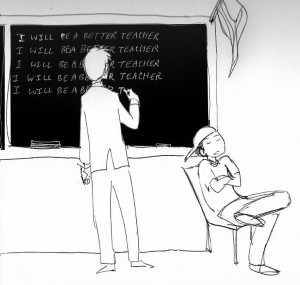Students need A+ teachers
The Los Angeles Times recently rattled the Los Angeles Unified School district with the release of an article analyzing the abilities of individual teachers to improve their students’ performance on standardized tests. What’s being referred to as the “value-added analysis” approach has created controversy over how administrators can evaluate teachers and to what extent this information will affect the education system, hiring policies and professional reputations.
The move has garnered both prominent criticism and support, from the L.A. teachers union President A.J. Duffy calling a massive boycott of the Times to the official endorsement by the Secretary of Education Arne Duncan.
Although the harsh reality of gauging teachers’ abilities from test scores has caused many an indignant response from proponents of the public school system, this new form of analysis is ultimately beneficial when it comes to tackling the myriad problems of the education system. It moves the discussion from the abstract factors of budgets and geography toward the more specific and concrete factors of what happens in individual classrooms.
But offensive as the idea might seem at the outset, we deserve the highest standards of performance from our teachers, and to know whether or not those standards are being met.
Understandably, this kind of statistical analysis can change the educational game significantly, exacerbating the success-at-all-costs mindset perpetrated by No Child Left Behind to improve students’ test scores and increase the blame — and burden — on teachers. However, this break from the norm could be exactly what the California education system needs in this era of budget crises and educational policy reform. It stirs the will to act in parents, students, teachers and administrators alike.
The implementation of in-depth analyses in teacher evaluation reflects a favorable shift that states parents and students have a right to demand better of their teachers. The ramifications of these analyses reach all levels of education, raising the question of how can we, the students, go about getting better teachers or improving the ones we already have.
The differences between us as university students and those still in grade school are significant. For younger students, it’s the parents and administrators who carry the brunt of the crusade, fighting for quality education on behalf of students who cannot fully articulate what they want from their teachers. But those of us enrolled in college are more likely to face the situation head-on because we pay tens of thousands of dollars for our education.
As students, we have professor evaluation forms to voice our opinions, which do have some effect on whether up-and-coming instructors are offered more classes or will be hired full-time. There is little a student can do, however, to offer criticisms to tenured professors other than hope they look through evaluations for ways to improve their teaching methods.
The system of “value-added analysis” suggested by the Los Angeles Times and being considered for district-wide teacher evaluation would become a new standard for grade school teachers to achieve in order to improve LAUSD’s quality of education. Ultimately, younger students must be prepared to graduate and pursue higher education (should they choose), and this particular analysis of whether teachers equip their students with the skills to take standardized tests is an essential standard all educators should meet.
If we are to demand that our public high school teachers prepare students for standardized tests and other hurdles needed to get into elite universities, what should we demand of the professors teaching at those universities?
For some, college is a place where students can learn for the intrinsic value of learning itself. For others, however, college is the ticket that all of us hope will land us a sustainable and fulfilling job. Just as these “value-added analyses” gauge whether grade school teachers prepare students for higher education, university students should have a system that gauges whether college professors adequately prepare their students for careers and the ever-scary real world.
According to the National Center for Education Statistics, California ranks at a dismal 47th in the nation in public school test scores. This disparity between California’s less-than-stellar public grade school system and world-renowned universities, such as the UC system, is a cause for shame. Students in California high schools are finding it increasingly difficult to get into good colleges, especially in the UC system as budget crises are causing those schools to accept more and more out-of-state students to compensate, raising the competition among in-state students.
An analysis system for public high schools would benefit classrooms by polishing the end-focus of preparing students for more advanced education. This system might be difficult to implement as it would require keeping in contact with numerous alumni and calculating complex factors that would compare job satisfaction and other extenuating components. But the end result for all students is the same: We must demand that our teachers equip us with the skills we need to face the next stage in life.
Victor Luo is a senior majoring in creative writing.

